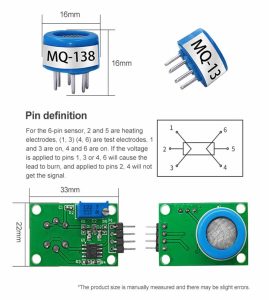-
Where is the gas sensor mainly used?
- Gas sensors are electronic devices that detect and measure gas concentrations. They are widely used in various industries, including environmental monitoring, industrial safety, medical diagnosis, and food processing. Gas sensors have bec……
- Chat Online
-
Description
Gas sensors are electronic devices that detect and measure gas concentrations. They are widely used in various industries, including environmental monitoring, industrial safety, medical diagnosis, and food processing. Gas sensors have become a crucial tool for ensuring the safety, health, and quality of life of people. In this article, we will explore where gas sensors are mainly used and their applications in different fields.

Environmental Monitoring
One of the most significant applications of gas sensors is environmental monitoring. Gas sensors can detect and measure the concentration of various gases in the air, which is essential for protecting the environment and human health. For example, carbon monoxide (CO) is a toxic gas produced by incomplete combustion of fossil fuels. It can cause headache, nausea, and even death at high concentrations. Therefore, CO sensors are widely used in homes, offices, and vehicles to detect and alert people to the presence of CO. Similarly, nitrogen dioxide (NO2) sensors are used to monitor the air quality near highways and industrial areas, where NO2 levels are often high.
Industrial Safety
Gas sensors are also widely used in industrial safety. In many industries, workers are exposed to hazardous gases, such as hydrogen sulfide (H2S), methane (CH4), and ammonia (NH3). These gases can cause explosions, fires, or health problems if their concentrations exceed the safety limits. Gas sensors are used to detect and alert workers to the presence of these gases in the workplace. For example, H2S sensors are commonly used in oil and gas production, where H2S is a common byproduct of oil extraction. Methane sensors are used in coal mines to detect the presence of explosive gases. Ammonia sensors are used in refrigeration systems to monitor the leakage of ammonia gas, which is highly toxic.
Medical Diagnosis
Gas sensors can also be used in medical diagnosis. The human body produces various gases, such as carbon dioxide (CO2), ammonia (NH3), and nitric oxide (NO). These gases are biomarkers that can indicate the presence of certain diseases or disorders. For example, exhaled breath contains trace amounts of CO2, NO, and NH3, which can be used to diagnose respiratory diseases, such as asthma and chronic obstructive pulmonary disease (COPD). Similarly, NO sensors can be used to diagnose and monitor inflammatory diseases, such as asthma, cystic fibrosis, and bronchitis.

Food Processing
Gas sensors are also used in food processing to ensure the quality and safety of food products. For example, oxygen (O2) sensors are used in food packaging to monitor the oxygen levels inside the package. Oxygen can cause spoilage and discoloration of food products, so it is important to maintain the optimal oxygen level for each type of food. Carbon dioxide (CO2) sensors are also used in food packaging to extend the shelf life of food products. CO2 can inhibit the growth of bacteria and fungi that cause spoilage and deterioration of food products.
Conclusion
In conclusion, gas sensors are essential tools for detecting and measuring gas concentrations in various applications. They are widely used in environmental monitoring, industrial safety, medical diagnosis, and food processing. Gas sensors play a critical role in ensuring the safety, health, and quality of life of people. With the advancement of technology, gas sensors will continue to be improved and developed, leading to more efficient and accurate detection of gas concentrations.
-
Recommend:
-
-
The Role of Gas Detectors in Safeguarding Public Health
Gas detectors play a crucial role in ensuring public safety…
-
Enhancing Safety Measures: Gas Detection Devices for Improved Workplace Security
Introduction: Ensuring workplace safety is of paramount imp…
-
Gas detectors are essential devices used to detect and moni…
-
Gas sensors are electronic devices that detect, measure, an…
-
 : +86 155 8830 2704
: +86 155 8830 2704 : jxdziot@gmail.com
: jxdziot@gmail.com
